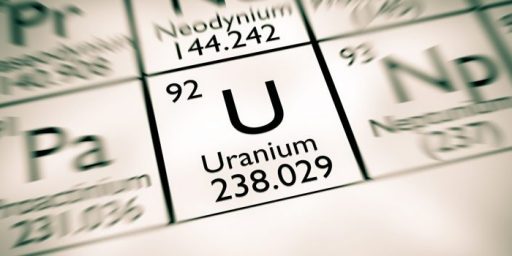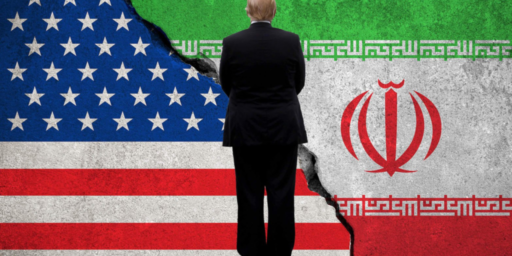Nuclear Iran 5-14 Years Away?
The NYT has a big story out today entitled, “Analysts Say a Nuclear Iran Is Years Away.” It clearly is intended to counter the claims yesterday by a high ranking State Department official that Iran could have materials to make a bomb in 16 (now, 15) days.
Western nuclear analysts said yesterday that Tehran lacked the skills, materials and equipment to make good on its immediate nuclear ambitions, even as a senior Iranian official said Iran would defy international pressure and rapidly expand its ability to enrich uranium for fuel. The official, Muhammad Saeedi, the deputy head of Iran’s atomic energy organization, said Iran would push quickly to put 54,000 centrifuges on line — a vast increase from the 164 the Iranians said Tuesday that they had used to enrich uranium to levels that could fuel a nuclear reactor.
Still, nuclear analysts called the claims exaggerated. They said nothing had changed to alter current estimates of when Iran might be able to make a single nuclear weapon, assuming that is its ultimate goal. The United States government has put that at 5 to 10 years, and some analysts have said it could come as late as 2020.
John Aravosis, Pachacutec, David Swanson, Oliver Willis, and others on the left are seizing on this meme (mostly settling on the TEN YEARS figure from the National Intelligence Estimate) to argue that we have plenty of time to formulate an Iran policy. Indeed, enough to wait until someone other than Bush is president.
I wonder why Arvosis and company are suddenly so confident in the predictive powers of our intelligence apparatus? The same people who got it wrong on Iraq’s WMD, were totally surprised when North Korea went nuclear, missed the signs pointing to 9/11, and totally did not see the end of the Cold War coming are now infallible? [Update: This is not so much a criticism of the IC but a recognition of the incredibly difficult nature of the enterprise. Getting it wrong a significant percentage of the time, sometimes spectacularly so, is inevitable.]
While I am admittedly no expert in nuclear physics, let alone privy to the raw intelligence and corps of expert analysts that those responsible for making these decisions have, my strong guess is that five years is a much more likely planning figure than fifteen days. Still, given that virtually everybody agrees that a nuclear armed Iran is unacceptable, wouldn’t erring on the side of believing Iran’s hype be more sane than pushing all our chips in on the idea that we have TEN YEARS?
Arvosis ends his post, which is a set of proposed Democratic talking points on Iran, with a legitimate question:
Why is it always us?
If Iran is such a threat, then why not let the Europeans and the Russians and the Chinese take care of it? Clearly none of those countries wants a nuclear Iran on their back porch. So why is it always America that has to give our money, our soldiers’ lives, and our goodwill?
In principle, I agree. The fact of the matter, though, is that the United States has become The World’s Last Remaining SuperpowerTM and, as Peter Parker learned the hard way, with great power comes great responsibility.
The Russians and Chinese are nuclear powers but not exactly world class militaries. Neither has shown any recent willingness to take on any obligations outside their immediate region. The Europeans, with the partial exception of the United Kingdom, have let their militaries atrophy to the point that they simply lack the ability to project power. The Israelis could do something, I suppose, and may even do it on their own if we wait around too long for their tastes. But that has its own set of problems.
If the United States acts, presuming we let the present diplomatic course run out, we will do it with many allies. Certainly the UK, Canada, and Australia will participate. Most likely, NATO generally will throw in, too. The French and Germans have definitely signaled their willingness. But, like it or not, if the US is not in, those countries are unlikely to do anything. They wouldn’t even act when the former Yugoslavia was breaking up in their own backyard and creating a major refugee problem. They’re certainly not going to get embroiled in a potential Middle East nightmare on their own.





Right, let’s bomb them now. While we’re at it, we better get North Korea. Hell, the French are getting a bit surly too–why not bomb them, too? They will be an easy target since they “simply lack the ability to project power.”
Now that Bush capitulated to India, fueling the nuclear arms race between them and Pakistan, we probably should bomb them both, for good measure.
If you read far enough into the NYT article there’s another quote from David Albright that suggests that a cascade of 3,000 centrifuges is probably realistic which would put the timeline out to about one year.
Why us? Because we’re the only ones with the ability to project appreciable power beyond our borders.
Look, I don’t recommend, suggest, propose, or look forward to military action against Iran. But ruling it out categorically is counter-productive.
BTW, Aravosis’s question is one of the reasons that I opposed U. S. military participation in the Balkans: it was a European mess that Europeans should have been in a position to deal with themselves. Our participation enabled the Europeans to continue to underfund their militaries.
Dave: Agreed on all counts. I didn’t think the Balkan mess was worthy of our involvement and certainly hope we can avoid military action in the Iranian mess, since none of the analyses I have read conclude that it will be pretty. Unfortunately, I have little confidence that the diplomatic string with the UN will play out successfully, either.
Ten years!?
Uh, guys, the Manhattan Porject was started in 1939 with the Einstein-Szilard letter to Roosevelt and detonated, yes detonated, a nuke in less than 6 years.
Ten years?!
And the will. Assuming we do, in fact, still have that.
I was under the distinct impression that the type of centrifuge that is capable of enriching uranium was a very tightly controlled international export item (for exactly that reason). If Iran was suddenly able to get their hands on 16000 (or even 3000) of those things without _anyone_ in the international intel and weapons proliferation community noticing before now, that’s a failure on a scale to make 9-11 look like chump change…
RTFA, legion.
Oh, come on. Russia’s right next door; they wouldn’t have to “project force” very far in order to blow up the necessary buildings.
M1EK, they had trouble projecting force to Chechyna, within their own borders. They are a shell of their Soviet era force on the conventional side.
I did R the FA, Dave. Let’s look at it together, shall we?
They _want_ to run 54000. They _seem_ to have 164 now (but that number hasn’t been confirmed outside Iranian press releases, so it could just be smoke as well). Unnamed western analysts don’t think they can meet their goals.
I think we all agree there’s a lot of Iranian posturing in this affair.
So, they’ve been rattling this saber for awhile now, and experts still don’t think they have a lot of high-precision manufacturing capability for this kind of gear.
So it took 28 years for Iran to get to the point of making low-grade reactor fuel with (perhaps) 164 centrifuges. And nobody seems to think they have the ability to build centrifuges able to make weapons-grade uranium.
So they _might_ have enough parts to build 2000 more centrifuges. But that estimate: doesn’t take into account spares for breakage and wear-and-tear, doesn’t take into account the complexity of managing that large a ‘cascade’ operation, and doesn’t specify whether the centrifuges are able to make the 80%-90%+ pure uranium needed for a weapon or just the ~30% pure stuff needed for reactor fuel.
So the conclusion I come to is that Iran can’t do a whole lot on their own yet – if they really want to join the a-bomb club, they’re going to have to get (or have already gotten) outside assistance. That bloody well ought to be hard to hide. Have I missed anything?
Legion wrote
Most Pressurized Water Reactors use 3.5-4% enrichment, so your numbers are way off.
And 2000 sets of spares for 165 running machines is absurd. And why are Iranians comsidered incapable of building their own, given their tremendous numbers of trained engineers and scientists from Western Universities dating back to the Shah’s time?
My view is the availability of electricity to power Uranium enrichment devices is what the Iranians lack. The American facilities were sited at Oak Ridge (TVA) and Hanford (Bonneville) for the availability of electricity. Enrichment takes a tremendous amount of electricity, and Iran today produces less electicity today than the USA in 1945.
Ooops, good catch on the enrichment numbers, Richard. I must’ve had a brain fart.
As for the spares, the Iranians themselves are talking about running these devices pretty much flat-out 24×7, in order to produce a usable amount as quickly as possible. I’m not an engineer, but I have a hard time believeing those systems were meant for that kind of abuse. After a certain amount of time, those centrifuges will start to wear – if they’re lucky, it won’t result in a catastophic release of radioactive material… I wouldn’t lose any tears over the people responsible, but a crash like that could irradiate a large chunk of city…
And finally, technical skill is only one aspect of Iran’s project – they still need extremely precise design and manufacturing facilities to produce those devices in-country, especially if you want to get weapons-grade products.
Legion, I am an engineer, and have lots of experience in the nuclear end of things. Except for filters that clog (and can and must be re-manufactured) there really aren’t that many items that that wear out in a Uranium-Hexaflouride gaseous diffusion cascade. These aren’t spare parts, and it is racism to assume the that Iranians can’t make these on their own. I repeat, 2000 spares for 165 units is absurd. (I would accept 1 to 1 for spares (100%), but usually it is at most 50%)
Richard,
I’ll bow to your experience on the centrifuges, but I take issue with calling my assumptions ‘racism’. There is a vast infrastructure needed to develop nuclear weapons, and there are many (most, thankfully) countries that simply don’t have that infrastructure; just as there are many countries that can’t put a man on the moon. It’s not racism, just simple economics.